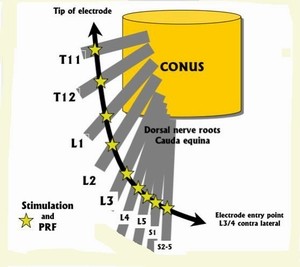Latest News
Spinal Canal stimulation
Electrical Nerve Stimulation for Chronic Pain
Electrical nerve stimulation is a procedure that uses an electrical current to treat chronic pain. Peripheral nerve stimulation (PNS) and spinal cord stimulation (SCS) are two types of electrical nerve stimulation. In either, a small pulse generator sends electrical pulses to the nerves (in peripheral nerve stimulation) or to the spinal cord (in spinal cord stimulation). These pulses interfere with the nerve impulses that make you feel pain.

Nerve stimulation is done in two steps. To see if it will help your pain, your doctor will first insert a temporary electrode through the skin (percutaneously) to give the treatment a trial run. The electrode is connected to a stimulator that the patient can control. If the trial is successful, your doctor can implant a permanent stimulator under your skin. This is typically done using a local anesthetic and a sedative. The stimulator itself is implanted under the skin and the small coated wires (leads) are inserted under the skin to the point where they are either connected to nerves or inserted into the spinal canal.
After this outpatient procedure is complete, you and your doctor determine the best pulse strength. You are then told how to use the stimulator at home. A typical schedule for spinal cord stimulation is to use it for 1 or 2 hours, 3 or 4 times a day.
When in use, electrical nerve stimulation creates a tingling feeling.
.jpg)
What To Expect After Treatment
You will have a small incision that you should keep clean and dry until it heals.
Why It Is Done
This treatment may be done for people with severe, chronic pain who have:
- Failed back surgery syndrome.
- Severe nerve-related pain or numbness.
- Chronic pain syndromes, such as complex regional pain syndrome.
Electrical nerve stimulation is typically considered investigational for various other conditions, including multiple sclerosis, paraplegia, and intractable angina.
How Well It Works
There isn't a lot of evidence to show how well spinal cord stimulation works. It seems to help certain types of chronic pain, such as failed back surgery syndrome and complex regional pain syndrome.1 Spinal cord stimulation may also help chronic low back pain.
Some researchers have reported that more than half of people receiving spinal cord stimulation for chronic low back and leg pain, ischemic leg pain (for example, from peripheral arterial disease), or complex regional pain syndrome have pain reduction or relief.
There is some evidence that peripheral nerve stimulation helps certain types of chronic pain, such as peripheral nerve pain and pain after surgery. Studies so far have been small.4
Initial pain relief is often followed by a gradual decline in effectiveness. Apparently, this is caused by the body's increasing tolerance to the treatment.
Risks
Possible risks related to electrical nerve stimulation include:
-
Scar tissue (fibrosis) developing around the electrode.
- Pain gradually moving beyond the reach of the nerve stimulator.
- Breakage of an electrode or hardware failure.
- Infection.
- Leakage of spinal fluid during spinal cord stimulation.
- Headache from spinal cord stimulation.
- Bladder problems in spinal cord stimulation.
- Getting used to the stimulation, making it less effective.
People with an implanted stimulator can't have magnetic resonance imaging (MRI) tests.
What To Think About
There is still not strong proof that electrical nerve stimulation works. Better research is needed. Treatment success varies widely and is influenced by the cause of pain.
Electrical nerve stimulation may be recommended for some people who have certain types of chronic pain






